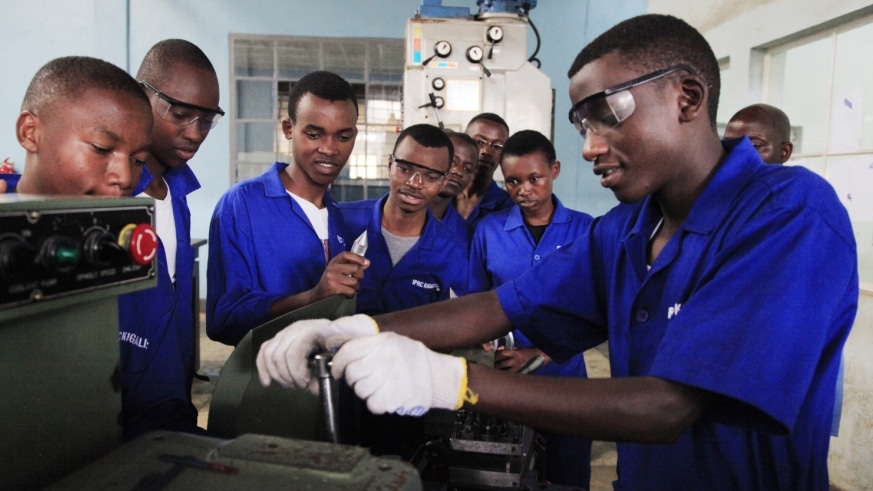Youth receiving instruction at a Kenyan TVET institution. The TVET system in Kenya is offering hope to thousands of youth who are acquiring skills to prepare for the job market, or entrepreneurship.
- The combined complement of Kenyan public and private universities churn out 500,000 graduates every year, and a total of 800,000 youth enter the Kenyan labour market annually. Youth unemployment is estimated to be around 35%, compared to the overall national unemployment rate of 10.4%, exacerbated by the shocks of Covid 19.
- Working with youth and improving their job-readiness is possible through TVET. Deployed within the CBET framework, it will raise their chances in the job market and bolster the confidence of the employment market players.
By Eric Obwogi
Kenya should be ranked among the most optimistic countries in the world today. Rightly so, because according to UN estimates and Kenya Bureau of Statistics, Kenya is a youthful country. 35.7 million People in the East African country (approximately 75%) are aged under 35 years.
Without doubt, this paints the picture of a country dominated by an energetic population that should spur it to achieve her national development ambitions like vision 2030, and the millennium development goals (MDGs).

At a time when Kenya is gearing up, together with other African countries, not to be left playing catch – up again in the next (fourth) Industrial Revolution, why then are the clouds swirling in the country’s sky significantly darker, with the feeling of hopelessness among the lot of the youth almost palpable. For a country with a youth bulge that is the envy of many countries (educated, industrious and ready to work anywhere in the world, at any time), this is a significant conundrum.
Unfortunately, a huge percentage of this population of “future leaders” is unemployed and feels marginalised in terms of access to opportunities, representation and participation in the national socio-economic realm.
In February, President Uhuru Kenyatta was in Kasarani, Nairobi, presiding over the conclusion of MbeleNaBiz Business Plan competition organized by the country’s Ministry of ICT and Youth Affairs under the Kenya Youth Enterprise and Opportunities Project. In this undertaking, 750 winners will be granted a total of KSh. 1.3B (about USD 135 M).
In a year, since March 2020, the Kenyan government has disbursed KSH 501M through the Youth Enterprise Development Fund to support youth-run enterprises affected by the coronavirus pandemic. Youth-run enterprises government loans cap will be KSh. 16 Billion, up from KSh. 13 Billion.
Picture this: The combined complement of Kenyan public and private universities churn out 500,000 graduates every year, and a total of 800,000 youth enter the Kenyan labour market annually. Youth unemployment is estimated to be around 35%, compared to the overall national unemployment rate of 10.4%, exacerbated by the shocks of Covid 19.
So, those who acquire some training after high school graduate but are confronted by a tepid and reluctant job market.
Focus should be on equipping the young men and women to change their circumstances and stop wallowing in self-pity and blaming the status quo. It is to help them understand that The people who get on in this world are they who get up and look for the circumstances they want, and If they can’t find them, make them – George Bernard Shaw.
But how do youth get out there and improve their lot? They need a helping hand to start off. Kenyans are industrious and the country’s youth are no exception.
Incomplete skills development has been a problem that frustrates the labour industry. While business owners are reluctant to invest time and resources to retrain recruits, the system deployed to solve their problem has proven insufficient. The result is jobs are hard to come by for the youth, and employers cannot recruit competent staff who can be competitive in the global market.
The 8-4-4 system which was created in 1985 was designed to impart appropriate market – led skills to promote self-employment among the youth. However, due to the high costs of implementation, and inadequate facilities there was a rise in school drop-outs.
Technical and vocational education and training (TVET) emerged as the major solution to this bottleneck.
TVET has been properly mainstreamed, and significant efforts made to reverse years of neglect. A massive expansion of TVET capacity with commensurate budgetary resources committed by Government was key. Some of the commitments include a promise to build a Technical Training Institution in each of the 290 Constituencies, processes to revamp the Vocational Training Centres (VTC) network by County Governments and a commitment to expand National Polytechnics and Universities dedicated to TVET.
The most significant action to advance TVET was the passage of the TVET Act of 2013, ostensibly to pave way for formation of Ministry Departmental Agencies (MDA’s) under the Ministry of Education.
These include; the State Department of Vocational and Technical Training (VTT), responsible for all TVET institutions – National Polytechnics, Technical Training Institutes, Technical Training Colleges, Vocational Training Centres (VTCs), and Technical and Vocational Educational and Training Authority (TVETA) – responsible for registration, licensing and regulation of the entire TVET sector; the Technical and Vocational Educational and Training Curriculum Development, Assessment and Certification Council (TVET CDACC) – responsible for TVET curriculum development and certification and the Kenya National Qualifications Authority (KNQA) – in charge of coordination and harmonization of education, training, assessment and quality assurance of all qualifications awarded in the country and recognition of prior learning (RPL)
Industry players now consider TVET a solution for their work force development solutions. However, some industry stakeholders still call for continuous improvement to mitigate the time and resources required to retrain TVET graduates entering the workforce.
Why? “The current TVET system in Kenya is largely based on theoretical training that to some extent gives less attention to the assessment of competence as per the expectations of potential employers, who voice their dissatisfaction based on the observation that it insufficiently prepares young people for the employment requirements.” This is according to the Competence Based Education and Training, CBET Policy Framework.
Make CBET work and, with links to TVET, there will be a paradigm shift from a supply-led to a demand-driven skills training and support approach.
TVET has worked wonders in other countries, and it can work here in Kenya through the CBET framework. The beauty of CBET is that it has borrowed from the best in the world to outline guidelines which, if followed, will lead to a reformed, more effective TVET system.
Working with youth and improving their job-readiness is possible through TVET. Deployed within the CBET framework, it will raise their chances in the job market and bolster the confidence of the employment market players.

